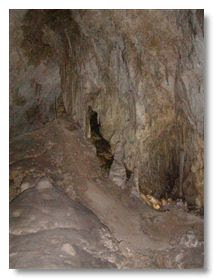Carlsbad Caverns is one of those "must see" places in the American Southwest. These pictures do not show the spectacular displays to be seen at every turn along the trails through the caverns.
Evidence of occupation by the ancients indicates their presence 1000 years ago.
In the 1800s early settlers were drawn to it by the summer-time nightly bat flights leaving the
entrance. It became a National Monument in 1923 and is still under exploration as new passages
are discovered. We took the 1-mile walking tour through the Big Room and that is where these photos were shot. Because of the size and distance and darkness, the flash is not able to carry far enough to
lighten the formations totally.
You will have to believe me when I say it is just breathtaking and indeed, a "must see" place.

 |
| The story of the creation of Carlsbad Cavern begins 250 million years ago with the creation of a 400 mile long reef in an inland sea that covered this region. This horseshoe shaped reef formed from the remains of sponges, algae and seashells and from calcite that precipitated directly from the water. Cracks developed in the reef as it grew seaward. Eventually the sea evaporated and the reef was buried under deposits of salts and gypsum. |
 |
| Then, a few million years ago, uplift and erosion of the area began to uncover the buried rock reef. Rainwater, made slightly acidic from the air and soil, seeped down into the cracks in the reef, slowly dissolving the limestone and beginning the process that would form large underground chambers. At the same time, hydrogen sulfide gas was migrating upward from vast oil and gas deposits beneath the ancient reef. This gas dissolved in the percolating ground water to form sulfuric acid. The added power of this corrosive substance explains the size of the passageways. The exposed reef became part of the Guadalupe Mountains and the underground chambers became the wonder of Carlsbad Cavern |

 |
| The decoration of Carlsbad Cavern with stalactites, stalagmites and an incredible variety of other formations began more than 500,000 years ago after much of the cavern had been carved out. It happened slowly, drop by drop, at a time when a wetter, cooler climate prevailed. The creation of each formation depended on water that dripped or seeped down into the limestone bedrock and into the cave. As a raindrop fell to the ground and percolated downward, it absorbed carbon dioxide gas from the air and soil, and a weak acid was formed. As it continued to move downward the drop dissolved a little limestone, absorbing a bit of the basic ingredient needed to build most cave formations--the mineral calcite. |
Water flowing over the surface of a wall or floor deposited layers of calcite called flowstone.
 |
| Once the drop finally emerged in the cave, the carbon dioxide escaped into the cave air. No longer able to hold the dissolved calcite, the drop deposited its tiny mineral load as a crystal of calcite. Billions and billions of drops later, thousands of cave formations had taken shape. And, oh, the shapes they took! Where water dripped slowly from the ceiling, soda straws and larger stalactites appeared. Water falling on the floor created stalagmites. Sometimes a stalactite and stalagmite joined, forming a column. |
Another type of cave formation that decorated cave walls and even other formations was popcorn, which may have formed when water evaporated and left behind calcite deposits.
Carlsbad Caverns National Park was first designated a National Monument on 25 Oct 1923. It was re-designated a National Park on 14 May 1930. Carlsbad Caverns was also designated a World Heritage Site on 06 Dec 1995.
This area is called The Hall of Giants.
This park was established to preserve Carlsbad Cavern and numerous other caves within a Permian-age fossil reef. The park contains 83 separate caves, including the nation's deepest limestone cave - 1,597 feet (486.8 m) - and third longest. Carlsbad Cavern, with one of the world's largest underground chambers and countless formations, is also highly accessible, with a variety of tours offered year round.
And this is Fairyland because of the diminutive size of the formations.
This old ladder is left over from explorations done by the National Geographic Society.
Draperies were hung where water ran down a slanted ceiling.






























































